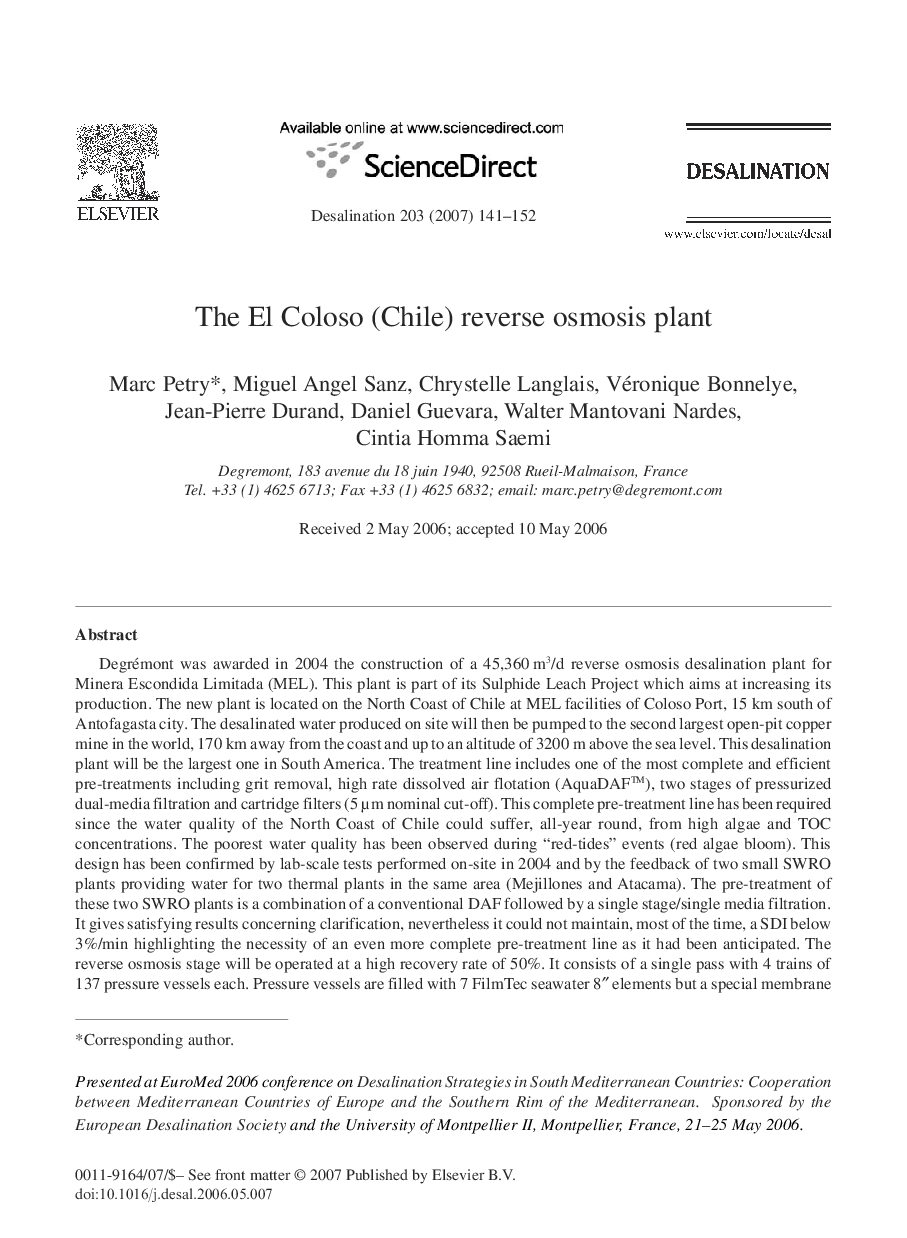| کد مقاله | کد نشریه | سال انتشار | مقاله انگلیسی | نسخه تمام متن |
|---|---|---|---|---|
| 628188 | 1455487 | 2007 | 12 صفحه PDF | دانلود رایگان |

Degrémont was awarded in 2004 the construction of a 45,360 m3/d reverse osmosis desalination plant for Minera Escondida Limitada (MEL). This plant is part of its Sulphide Leach Project which aims at increasing its production. The new plant is located on the North Coast of Chile at MEL facilities of Coloso Port, 15 km south of Antofagasta city. The desalinated water produced on site will then be pumped to the second largest open-pit copper mine in the world, 170 km away from the coast and up to an altitude of 3200 m above the sea level. This desalination plant will be the largest one in South America. The treatment line includes one of the most complete and efficient pre-treatments including grit removal, high rate dissolved air flotation (AquaDAF™), two stages of pressurized dual-media filtration and cartridge filters (5 μm nominal cut-off). This complete pre-treatment line has been required since the water quality of the North Coast of Chile could suffer, all-year round, from high algae and TOC concentrations. The poorest water quality has been observed during “red-tides” events (red algae bloom). This design has been confirmed by lab-scale tests performed on-site in 2004 and by the feedback of two small SWRO plants providing water for two thermal plants in the same area (Mejillones and Atacama). The pre-treatment of these two SWRO plants is a combination of a conventional DAF followed by a single stage/single media filtration. It gives satisfying results concerning clarification, nevertheless it could not maintain, most of the time, a SDI below 3%/min highlighting the necessity of an even more complete pre-treatment line as it had been anticipated. The reverse osmosis stage will be operated at a high recovery rate of 50%. It consists of a single pass with 4 trains of 137 pressure vessels each. Pressure vessels are filled with 7 FilmTec seawater 8″ elements but a special membrane arrangement (hybrid) has been decided. The first two elements in the pressure vessels are of “high rejection” type and the five following ones are of “standard” type. This peculiar arrangement has been chosen to maintain a correct flow pattern throughout the pressure vessel for the whole range of temperature (11–23°C) and with a changing feed pressure over the year due to the high recovery rate. Consequently, it provides a narrower flux distribution and a better permeate quality without affecting significantly the feed pressure. In addition, the design includes an energy recovery system consisting of Pelton turbines. Finally, flotation's sludge and filters' wash water are treated to meet the permitted suspended solids discharge concentration. From February to September 2005, a pilot-scale study has been conducted on site. The purpose of the study was: to demonstrate the relevancy of our design and to validate its efficiency whatever the raw water quality; to fine-tune the treatment according to the different raw water qualities in order to improve the commissioning of the full-scale plant. The pilot treatment line is representative of the full scale one with a production capacity of pre-treated water of more than 500 m3/h for a desalinated water production of 250 m3/h. Throughout the test period, the pilot plant has achieved to produce pre-treated water with a SDI between 2 and 3%/min more than 90% of the time, even during a “red-tide” period. These results prove the efficiency of the selected pre-treatment line especially with poor raw water quality. Moreover, RO operation at a high recovery rate of 50% has shown no flux, salt rejection nor pressure variation during the period of the test meaning that there was a low organic and mineral fouling rate. It is expected that this optimal pre-treatment design and this combination of membrane will allow a high recovery rate together with a low permeate salinity over the temperature range experienced at El Coloso site.
Journal: Desalination - Volume 203, Issues 1–3, 5 February 2007, Pages 141-152